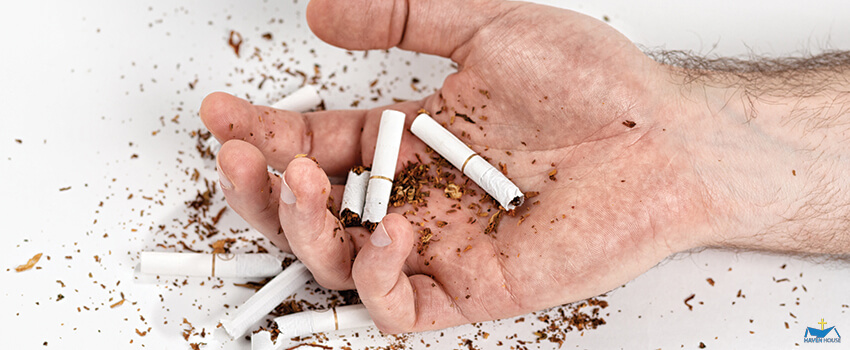

Table of Contents
Tobacco addiction is the leading cause of preventable disability, death, and disease in the United States. According to tobacco user statistics from the CDC, an estimated 2.55 million high school and middle-school students use at most one type of tobacco product, including e-cigarettes.
In the same tobacco user statistics, about 1,600 U.S. teenagers under 18 years old smoke their first cigarettes every day. Nearly half a million Americans are killed each year from secondhand smoke or smoking and tobacco addiction. According to the same tobacco user statistics, 16 million people live with serious illnesses caused by smoking, which is pretty alarming. The United States spends over $225 billion annually on medical care for adults suffering from smoking-related diseases.
Why Is Tobacco Addictive?
Smoking and tobacco addiction begin in the teenage years. People who smoke are more likely to have friends or parents who smoke. Teenagers may say they were just curious or wanted to start smoking.
The tobacco industry spends billions to create and market ads that promote different types of tobacco and smoking as glamorous, safe, and exciting. The ads and price break offered by the tobacco industry influence most of society. Video games, TV, and the internet all show tobacco use. Movies showing people smoking are another major influence. Research shows that young people who see smoking on screen are more likely to take up smoking than others.
Nicotine will make its way to your brain once absorbed into the bloodstream. Tobacco consumption from cigarette smoke, vape mist, or chewing tobacco triggers the brain to release dopamine, which gives people a pleasant feeling.
The brain develops a craving for nicotine over time. To get the same feeling, people will need to smoke more cigarettes. This is where tobacco addiction starts.
Nicotine also reacts with the adrenal glands. It triggers a release of adrenaline, which causes some users to feel energized or more focused.
Health Risk From Tobacco
Smoking can damage your lungs’ airways and air sacs. It can affect a person’s lung function as soon as they start. It may take several years before the symptoms become severe enough to warrant a diagnosis of lung disease.
Here are some of the health risks of tobacco use:
Chronic Obstructive Pulmonary Disease
Chronic obstructive lung disease (COPD) is a group of diseases that causes airflow obstruction and other breathing-related problems. COPD can include emphysema, chronic bronchitis, and in some cases, asthma.
COPD occurs when:
- The airways and air sacs lose the ability to expand and contract in the lungs.
- Many of the walls separating the air sacs are destroyed and no longer serve their purpose.
- The airway walls in the lungs are thick, inflamed, irritated, and swollen.
- Mucus in the airways is denser than usual, which causes obstructions and blocks airflow.
Smoking and tobacco addiction is the most common cause of COPD. Smoking is responsible for up to 8 of 10 COPD-related death. However, only 1 in 4 Americans with COPD have smoked cigarettes or experienced tobacco consumption.
Smoking during your childhood or teenage years can slow the growth and development of the lungs. It also increases the likelihood of COPD in adulthood.
Heart Disease
Smoking can cause various cardiovascular diseases by raising triglyceride, a type of fat in the blood. It lowers good cholesterol, giving blood a sticky consistency and making it prone to clotting. Smoking also damages the cells in the blood vessels.
Aside from the actual tobacco addiction, secondhand smoke also harms your health. Secondhand smoke refers to a mixture of smoke breathed out by smokers and the smoking end of cigarettes.
Inhaling secondhand smoke can lead to coronary heart disease, including stroke and heart attack. It is a major cause of heart disease in nonsmokers. It can increase your risk by 25%-30% if you are a smoker. The risk of stroke from secondhand smoke is 20-30% higher. Nonsmokers in the United States are more likely to die from secondhand smoke-related coronary heart disease than those who have smoked.
Cancer
Smoking and tobacco consumption can lead to cancer and make it harder for your body to fight it. Tobacco smoke has toxic chemicals that weaken the immune system. It makes it more difficult to eradicate cancer cells, which will continue to grow and difficult to stop.
DNA is the “instruction book” for a cell that regulates its normal growth and function. Tobacco smoke can alter or damage a cell’s genetic material. A cell with damaged DNA can grow out of control and become a cancerous tumor.
For a long time, doctors have known that smoking is the leading cause of lung cancer. This is still true today; nearly 9/10 of lung cancers are due to smoking cigarettes, even if they are smokeless. People are at greater risk of developing lung cancer than in 1964. One reason could be a change in the way cigarettes are made or the chemicals they contain.
Signs of Tobacco Addiction
Tobacco addiction is more challenging to conceal than other addictions. Tobacco is more accessible; it is legal and can be smoked in public, making it easier to become addicted.
Here are common signs that a person is addicted to tobacco and nicotine:
Relentless Smoking and Chewing
This is perhaps the most obvious sign that a person is addicted to tobacco and nicotine. Cigarettes are the most accessible form of tobacco, and people can buy them per pack for an affordable price.
People addicted to tobacco consume more than the average number of cigarettes. Some want a stronger hit; that’s why they purchase cigars or tobacco leaves they can consume by chewing.
Frequent Withdrawal Syndromes
People addicted to substances experience withdrawal symptoms when they abruptly stop consuming the substance they are addicted to. When a tobacco addict suddenly decides to stop consuming cigarettes and other sources of nicotine, they might experience intense shaking, sweating, mood swings, irritability, and rapid heart rate.
Withdrawal syndromes are caused by the body’s adaptation to the substance. Once the substance stops coming in, the body considers this an abnormality.
What to Do In Case of Tobacco Addiction
Tobacco addiction is treated with many different methods. However, it’s an addiction that is difficult to manage. Many people find smoking triggers their relapse, even after the cravings pass.
If you suspect a person close to you is suffering from tobacco addiction, you can do the following:
Offer the Patch
The patch is the most common treatment for smokers who are quitting the habit. It is also known as nicotine replacement therapy (NRT). The patch is a small bandage-like sticker you place on your arm or back. The body receives very low nicotine levels from the patch, allowing it to wean itself off nicotine gradually.
Offer Nicotine Gum
Quitting smokers may feel the need to put something in their mouths. Nicotine gum, another form of NRT, is used to help those who find it difficult to stop chewing or smoking tobacco. You can also get small amounts of nicotine through the gum to manage your cravings.
Consult a Professional
To treat tobacco addiction, you need to use a variety of methods. Remember, not all methods will work for everyone. It is always best to talk to your doctor about the best treatments and tobacco use prevention.
Haven House Recovery Helps Men Deal With Their Tobacco Addiction
You should encourage anyone you know or suspect is addicted to substances to seek help. Haven House Recovery Center, a recognized addiction recovery center in Santa Rosa Beach, FL, aims to help men from all walks of life get clean from their addiction.
Call us now to begin the journey to healing.
Newsletter Signup
Discipleship Training
“The teaching of the wise is a Fountain of Life, turning a person from the snares of death.”
Proverbs 13:14 NIV


